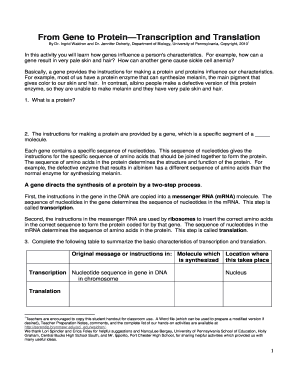
Get From Gene To Protein—transcription And Translation
How it works
-
Open form follow the instructions
-
Easily sign the form with your finger
-
Send filled & signed form or save
How to fill out the From Gene To Protein—Transcription And Translation online
This guide provides clear instructions on how to complete the From Gene To Protein—Transcription And Translation form online. By following these steps, users will be able to effectively understand and fill out the necessary components related to gene expression, transcription, and translation.
Follow the steps to fill out the form accurately.
- Click the 'Get Form' button to access the document and open it in the editor.
- Begin by reading through the introduction provided in the form. This section will give you context about how genes influence a person's characteristics, including specific examples like albinism and sickle cell anemia.
- Fill in the prompts related to proteins. The first question asks, 'What is a protein?' Provide a concise definition based on your understanding or refer back to the content in the form for context.
- In the next section, complete the statements where indicated. For example, when asked about the type of molecule that carries the instructions for making a protein, ensure you correctly identify and fill in the answer.
- Continue to the table summarizing the characteristics of transcription and translation. Input data into each cell based on the instructions or information discussed in the form.
- After completing the table, move on to the transcription modeling procedure. Follow the step-by-step instructions while partnering with another individual. Make sure to accurately represent the base-pairing rules as instructed.
- Proceed to the translation section, ensuring that you match tRNA molecules with the correct codons present in the mRNA you previously generated during transcription.
- Once all sections of the form are filled out, review your entries for completeness and accuracy. Make any necessary changes.
- Finally, save your progress and choose to download, print, or share the form as per your needs.
Complete the From Gene To Protein—Transcription And Translation form online to enhance your understanding of genetic processes.
To understand how we go from gene to mRNA to protein, we need to grasp the processes of transcription and translation. First, during transcription, a gene is copied to create mRNA. Then, in translation, this mRNA serves as a template to build a protein by linking amino acids together. This journey is essential for producing the proteins that support all biological functions.
Industry-leading security and compliance
-
In businnes since 199725+ years providing professional legal documents.
-
Accredited businessGuarantees that a business meets BBB accreditation standards in the US and Canada.
-
Secured by BraintreeValidated Level 1 PCI DSS compliant payment gateway that accepts most major credit and debit card brands from across the globe.


